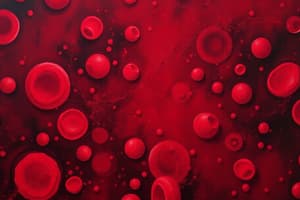Podcast
Questions and Answers
What is the main component of plasma?
What is the main component of plasma?
Which plasma protein is primarily involved in blood coagulation?
Which plasma protein is primarily involved in blood coagulation?
What condition is characterized by a defect in blood coagulation?
What condition is characterized by a defect in blood coagulation?
What is one of the functions of platelets?
What is one of the functions of platelets?
Signup and view all the answers
What role does albumin play in the blood?
What role does albumin play in the blood?
Signup and view all the answers
Which mechanism is NOT part of hemostasis?
Which mechanism is NOT part of hemostasis?
Signup and view all the answers
What does the spleen NOT do?
What does the spleen NOT do?
Signup and view all the answers
What is the normal platelet count range in the blood?
What is the normal platelet count range in the blood?
Signup and view all the answers
Study Notes
Blood Composition and Functions
- Blood consists of plasma and cells (red cells, white cells, and platelets).
- Plasma is the liquid portion of blood.
- Primarily water (90%).
- Contains inorganic constituents (0.9%).
- Plasma proteins (7.1%).
- Nutrient material and waste products (2%).
- Origin: tissue proteins and diet proteins.
Plasma Protein Functions
- Tissue metabolism: Essential for various bodily processes
- Blood coagulation: Critical for clotting using fibrinogen.
- Blood volume regulation: Plasma proteins, especially albumin, maintain osmotic pressure, impacting fluid balance and urine volume.
- Blood viscosity: Fibrinogen influences blood thickness.
- Buffering: Maintaining a stable pH.
- Immunity: Gamma globulins are crucial components of the immune system.
- Transport: Moving various substances throughout the body.
- Capillary permeability: Plays a significant role in maintaining capillary permeability.
Hemostasis and Blood Coagulation
- Hemostasis is the process of preventing blood loss and maintaining normal blood volume.
- Mechanisms include:
-
Vascular spasm:
- Local myogenic action (muscle contraction).
- Serotonin release by platelets.
-
Platelet plug formation:
- Platelet activation.
- A collection of platelets aggregating at the damaged site.
-
Blood coagulation:
- Prothrombin activator formation.
- Prothrombin conversion to thrombin.
- Fibrinogen conversion to fibrin threads.
-
Vascular spasm:
Platelets
- Fragments of megakaryocytes (giant cells in bone marrow).
- Normal platelet count: 200,000 to 400,000/mm³.
-
Functions:
- Hemostasis.
- Blood clotting.
- Clot retraction.
- Phagocytosis.
- Serotonin storage.
Abnormalities of Hemostasis
- Vitamin K deficiency: Impairs prothrombin formation.
- Hemophilia: Blood clotting disorder, specific factor deficiency.
- Thrombocytopenic purpura: Significantly low platelet count.
Spleen Functions
- Blood formation (in early development).
- Blood destruction.
- Defense reaction (e.g., immune responses).
- Blood reservoir.
Studying That Suits You
Use AI to generate personalized quizzes and flashcards to suit your learning preferences.
Related Documents
Description
Test your knowledge on the composition and functions of blood, including the roles of plasma and various blood cells. This quiz covers essential topics related to plasma proteins and their significance in bodily processes such as coagulation and immunity.




